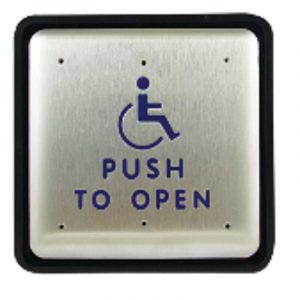Operating Hardware
Door hardware also has requirements for accessibility. One of the most common disabilities is “reaching and manipulation;” arthritis is the leading cause of disability in the United States, with more than 50 million adults and 300,000 children suffering from some form of the condition.
Door and Gate Hardware
Section 404.2.7 states operating devices installed onto doors (handles, pulls, latches, and locks) must be easy to grasp with one hand and not require tight gripping or twisting of the wrist to operate. Additionally, the highest point of the operating portion of the hardware shall be mounted no higher than 1220 mm above the finished floor. There can be no projection off the face of the door below 865 mm above the finished floor.

Opening Force
Section 404.2.9 calls for both interior hinged doors and sliding/folding doors to have an opening force of no more than 22.2 N (2.26 kg [5 lb]). Fire doors are a different matter. They shall have the minimum opening force allowed by the appropriate administrative authority. This does not apply to the necessary force to fully open the door, or the initial energy needed to start the door in motion. It also does not apply to the retraction of latches or disengaging devices used to keep the door in the closed position.
Exterior doors and fire-rated doors are both exempt from door opening and closing forces. Exterior doors must remain closed for security reasons, and the amount of pressure will vary depending on the indoor and outdoor temperatures, outside elements like wind, and the building’s HVAC system.
Fire-rated openings must be equipped with self-closing or automatic-closing devices to keep the door shut. However, to work effectively, doors must remain closed and latched upon activation of the fire alarm as life safety receives higher priority than accessibility.
Closing Speed
Much emphasis is placed on opening force, but the closing speed of a door is equally important. If a door closes too fast, it may hit someone and cause injury. This is addressed in Section 404.2.8, Closing Speed. If a door has a closer, then the sweep period of the closer shall be adjusted so that, from opening position of 70 degrees, the door will take a minimum of three seconds to move a point 76 mm (3 in.) from the latch, measured to the leading edge of the door.
Some closers have a special feature that delays the closing of a door, often called delayed action. This happens when the door is opened to 90 degrees and slowly pivots to 70 degrees. This feature is often used where it is beneficial to have a longer closing time. The closing cycle resumes a normal pace from 70 degrees back to 76 mm from the latch.
It is important to note the delayed action is optional, not required. Only the closing cycle is part of the ADAAG standard. According to 404.2.8.1, “Door closers and gate closers shall be adjusted so that from an open position of 90 degrees, the time required to move the door to a position of 12 degrees from the latch is five seconds minimum.”
This allows individuals more time to freely move through the opening.




